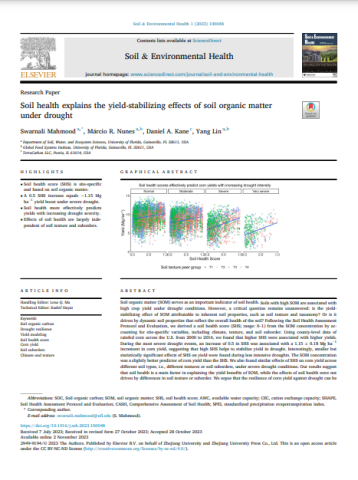Abstract
Soil organic matter (SOM) serves as an important indicator of soil health. Soils with high SOM are associated with high crop yield under drought conditions. However, a critical question remains unanswered: is the yieldstabilizing effect of SOM attributable to inherent soil properties, such as soil texture and taxonomy? Or is it driven by dynamic soil properties that reflect the overall health of the soil? Following the Soil Health Assessment Protocol and Evaluation, we derived a soil health score (SHS; range: 0–1) from the SOM concentration by accounting for site-specific variables, including climate, texture, and soil suborder. Using county-level data of rainfed corn across the U.S. from 2000 to 2016, we found that higher SHS were associated with higher yields. During the most severe drought events, an increase of 0.5 in SHS was associated with a 1.15 0.18 Mg ha1 increment in corn yield, suggesting that high SHS helps to stabilize yield in drought. Interestingly, smaller but statistically significant effects of SHS on yield were found during less intensive droughts. The SOM concentration was a slightly better predictor of corn yield than the SHS. We also found similar effects of SHS on corn yield across different soil types, i.e., different textures or soil suborders, under severe drought conditions. Our results suggest that soil health is a main factor in explaining the yield benefits of SOM, while the effects of soil health were not driven by differences in soil texture or suborder. We argue that the resilience of corn yield against drought can bepotentially increased by adopting agronomic practices aimed at augmenting SOM and improving overall soil health across a broad spectrum of geographical locations and site characteristics.
| Swarnali Mahmood, Márcio R. Nunes, Daniel A. Kane, Yang Lin 2023. Soil health explains the yield-stabilizing effects of soil organic matter under drought Soil & Environmental Health 1 (4) |
Download the full article below.


